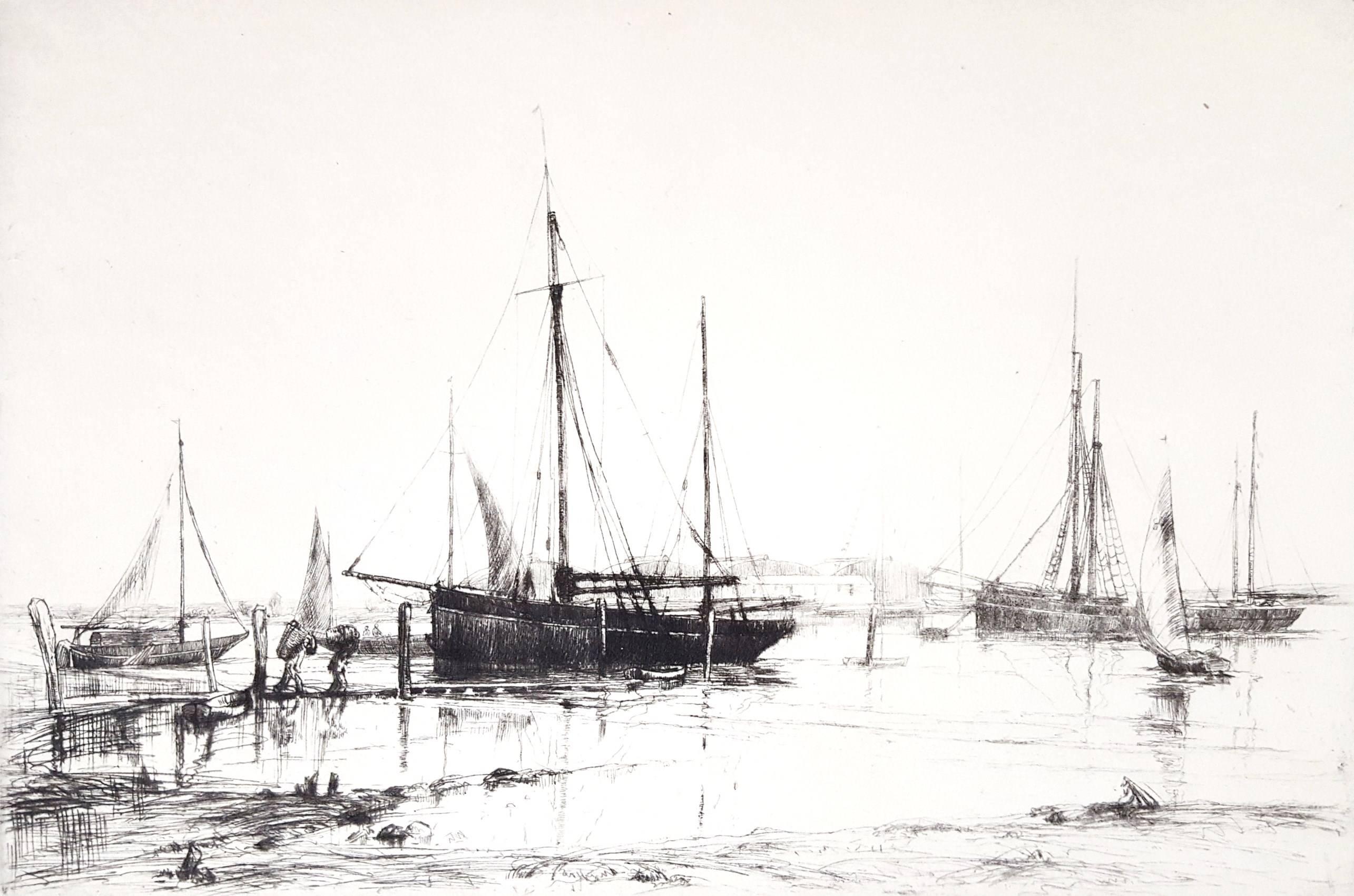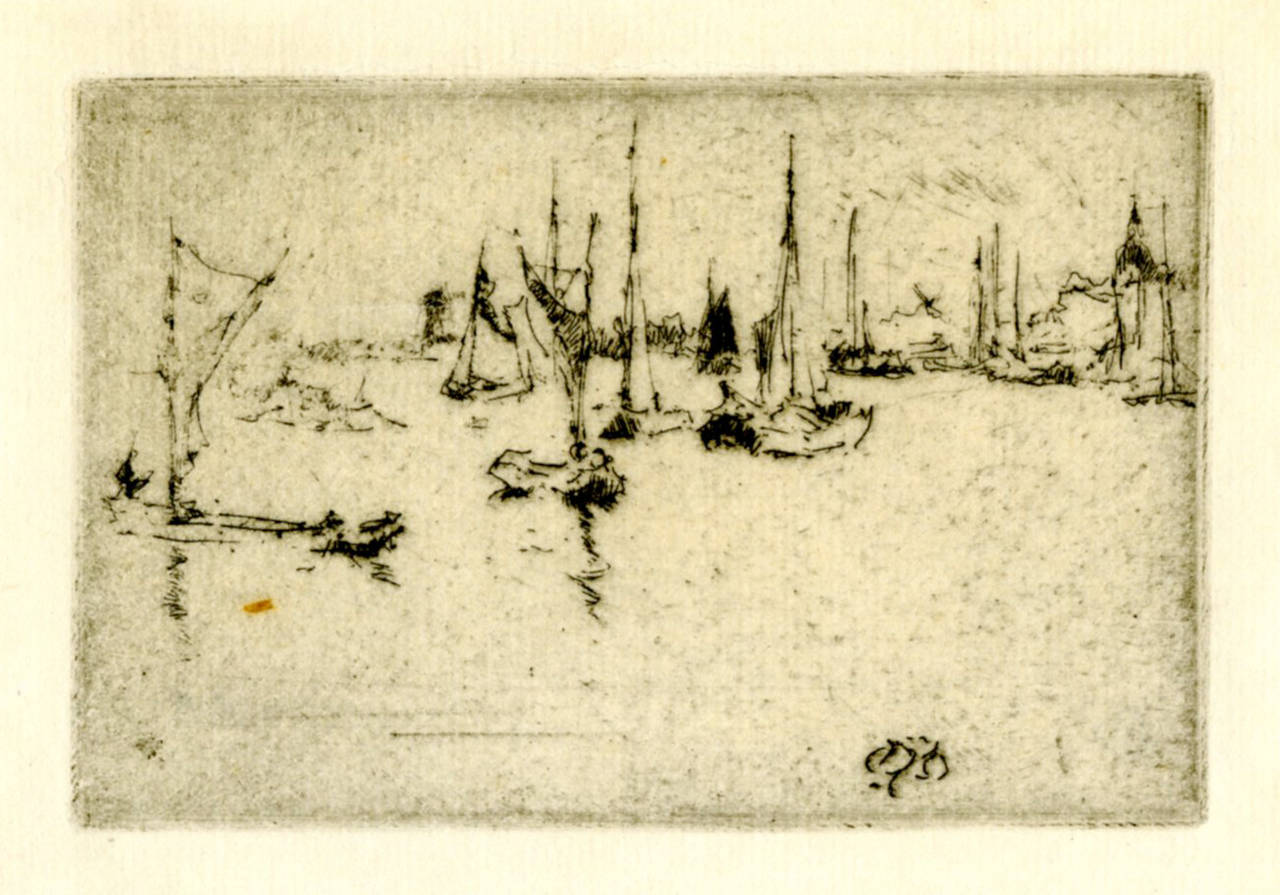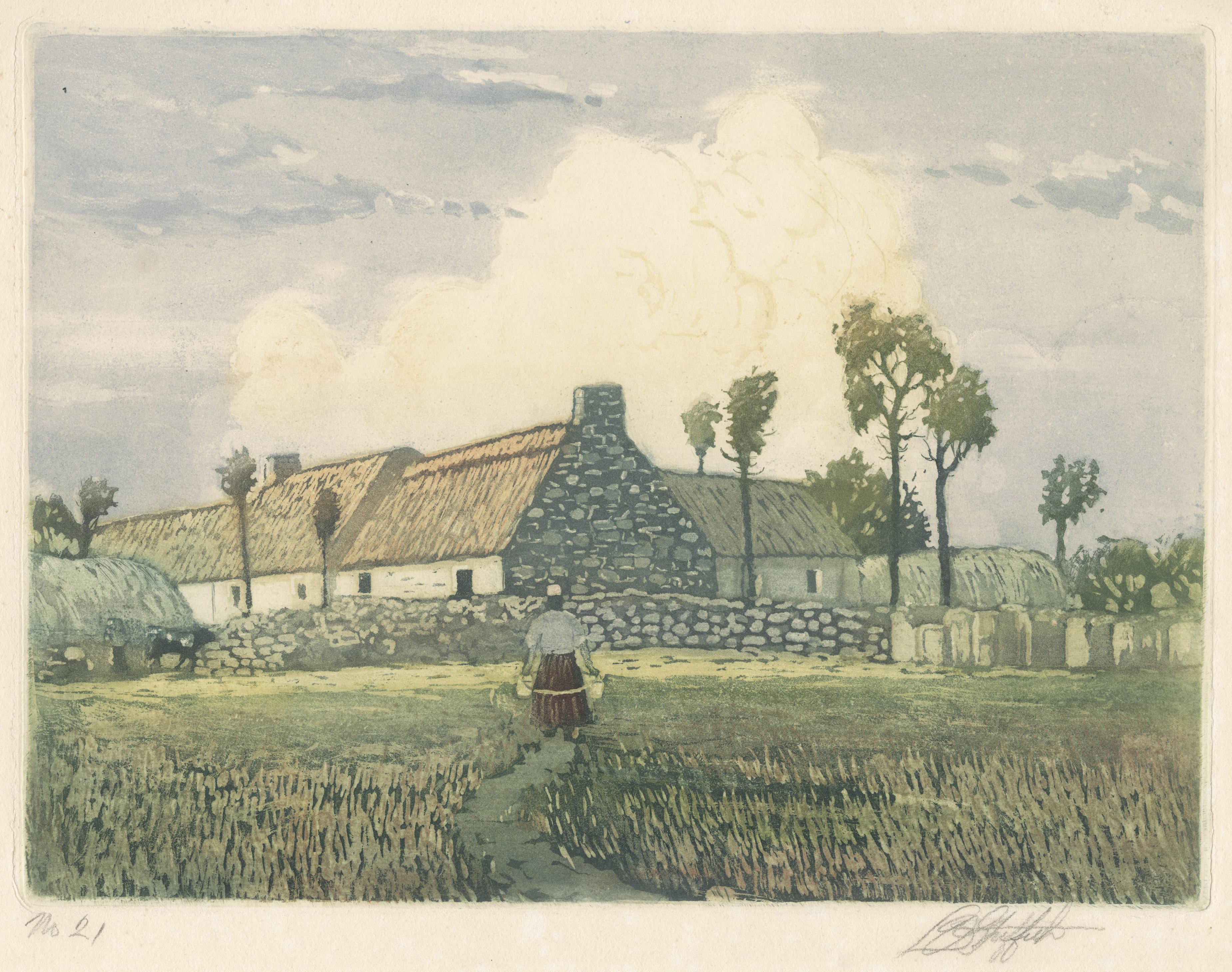Items Similar to Piazzetta, Venice
Want more images or videos?
Request additional images or videos from the seller
1 of 6
Jan C. VondrousPiazzetta, Venice1930
1930
About the Item
Jan Charles Vondrous, 'Piazzetta, Venice', color etching, 1930. Signed, dated, and titled in pencil. Signed and dated in the plate, lower right. A fine impression, on cream, laid paper, with full margins (2 1/4 to 3 1/8 inches), in excellent condition. Matted to museum standards, unframed.
ABOUT THE ARTIST
Born in Czechoslovakia in 1884, Jan C. Vondrous moved with his family to the United States at age nine. He studied etching at the National Academy of Design in New York, and at the painting studio of George Willoughby Maynard, and then graduated from the James David Smillie Stitching School. His first etchings, published during the First World War, focused principally on architectural views of New York City and the surrounding area. After the war, Vondrous spent much of the following decade traveling Europe to etch the urban landscapes of major European cities, particularly Bruges and Venice.
By 1926 Jan Vondrous had again returned to his native Czechoslovakia to settle permanently in Prague. During his remaining years, he continued to etch and paint the people and architecture of his beloved city.
Vondrous was a member of the Chicago Society of Etchers, the Print Makers' Society of California, and the Hollar Society of Prague. He received many awards for printmaking including, 1st place Baldwin Prize National Academy of Design, New York, 1901; 1st Hallgarten Prize for composition, 1903; Bronze Award for Etching, Panama - Pacific International Exposition, San Francisco, 1915; Honorable Mention of Helen Foster Barnett Prize, 3rd Annual Exhibition of the Brooklyn Society of Etchers, 1918; Logan Prize, Chicago Society of Etchers, 1917, 1918, 1919; Honors at the Sesqui–Centennial International Exposition, Philadelphia, 1926.
Examples of Vondrous' etchings are in the following museum collections: Art Institute of Chicago, Congressional Library (Washington, DC), The Modern Gallery of Prague (Prague), New York Public Library, Kupferstich Kabinett (Berlin), Smithsonian American Art Museum, Victoria and Albert Museum (London), British Museum (London).
- Creator:Jan C. Vondrous (1884 - 1956)
- Creation Year:1930
- Dimensions:Height: 13.63 in (34.63 cm)Width: 10.75 in (27.31 cm)
- Medium:
- Movement & Style:
- Period:
- Condition:
- Gallery Location:Myrtle Beach, SC
- Reference Number:
About the Seller
5.0
Recognized Seller
These prestigious sellers are industry leaders and represent the highest echelon for item quality and design.
Platinum Seller
These expertly vetted sellers are 1stDibs' most experienced sellers and are rated highest by our customers.
Established in 1995
1stDibs seller since 2016
254 sales on 1stDibs
Typical response time: 1 hour
Associations
International Fine Print Dealers Association
- ShippingRetrieving quote...Ships From: Myrtle Beach, SC
- Return PolicyA return for this item may be initiated within 7 days of delivery.
More From This SellerView All
- 'En Plein Soleil' from the French Set, 'Douze eau-fortes d'apres Nature'By James Abbott McNeill WhistlerLocated in Myrtle Beach, SCJames Abbott McNeill Whistler, 'En Plein Soleil' from the French Set (Douze eau-fortes d'apres Nature), etching, 1858, edition 61, 4th state of 4, Kenn...Category
1850s Impressionist Figurative Prints
MaterialsEtching
- Hungerford Bridge, LondonBy Kerr EbyLocated in Myrtle Beach, SCKerr Eby 'Hungerford Bridge, London', etching and sandpaper ground, 1929, edition 90, Giardina 144. Signed, titled, and annotated 'Ed 90' in pencil. Signed again in the bottom right sheet corner. A fine, atmospheric impression, with delicate plate tone, on cream wove paper; the full sheet with margins (1 1/2 to 1 5/8 inches), in excellent condition. Matted to museum standards, unframed. Hungerford Foot Bridge spans the River Thames in London, between Westminster Bridge and Waterloo Bridge. Eby visited Great Britain and France during 1924 and 1925. Impressions of this work are in the permanent collection of the following institutions: American Academy and Institute of Arts and Letters, Arizona State University, Boston Public Library, Davison Art Center (Wesleyan University), Herbert F, Johnson Museum of Art, Huntington Museum of Art, Hood Museum of Art (Dartmouth College), Metropolitan Museum of Art, Montgomery Museum of Fine Arts, National Museum of American Art, New York Public Library, Smithsonian Museum of American Art. ABOUT THE ARTIST Kerr Eby was born in 1890 in Tokyo, Japan, the son of Methodist missionaries from Canada. The family returned to Vancouver when Eby was only three, and he grew up studying art encouraged by his parents as his mother was from a family of prominent artists. By age twelve, he had lived in Vancouver, Kingston, Toronto and Bracebridge where he found work as a ‘printer’s devil’ on the local Bracebridge newspaper. After graduating from high school in 1907, Eby moved to New York City to study art, first at the Pratt Institute, and later at the Art Students League. He enrolled in art classes at Pratt Institute while working for a lithographic firm earning $4.00 a week. His pay barely covered his room and drawing supplies. Within a year, starving and feeling defeated, he returned to Canada and was employed by a surveying party in Northern Ontario. Eby gradually regained his dream of becoming an artist, and in his spare time, he began to draw the surrounding wilderness landscapes. By fall he had returned to New York to attend night classes at the Art Students League while working for another lithographic firm. He spent several more summers surveying in Northern Ontario before he was able to make a living as an illustrator. During this period he formed several friendships with influential artists including John Henry Twachtman and Childe Hassam and joined a summer artists' colony founded by them at Cos Cob, Connecticut. He supported himself by working as a magazine illustrator and at the American Lithographic Company. Through diligent study and practice, Eby refined both his drawing and printmaking techniques. In 1917, when the United States entered World War I, Eby joined the U.S. Army. Failing to obtain a commission as an artist, he was assigned first to ambulance duty and later as a sergeant in the 40th Engineers in France. He spent most of WWI on the front line as a camouflager of the field artillery ‘big guns”. On his time off duty, he would sketch everything he witnessed, from the explosive big guns and men in action to the dead soldiers in the field. He sent the drawings home each week, and upon his return from the war, they became the basis for his first successful group of etchings. He continued creating his war-related prints throughout the 1920s and '30s as his work became widely exhibited Frederick Keppel, the renowned print dealer and a relative of Eby, became the exclusive agent for many of his print editions. With another global conflict beginning in the mid-1930s, Eby wanted to show the world the true face of war...Category
1920s Impressionist Landscape Prints
MaterialsEtching
- St. Paul's Church (St. Paul's Chapel, New York City)By Bror Julius Olsson NordfeldtLocated in Myrtle Beach, SCB.J.O. Nordfeldt, 'St. Paul's Church' (St. Pauls' Chapel), etching, edition not stated, c. 1915. Signed in pencil. A superb, richly-inked impression, with skillfully controlled plate tone, printed on off-white, antique, laid paper; the full sheet with margins (5/8 to 2 1/4 inches), in very good condition. Scarce. Matted to museum standards, unframed. An impression of this work is in the permanent collection of the Smithsonian American Art Museum. ABOUT THE ARTIST A solo exhibition of Nordfeldt’s etchings and woodcuts was presented by the Smithsonian Institution in 1926. In 1920, Nordfeldt had a one-man show at the Chicago Arts Club. In 1926, he won the bronze medal at the sesquicentennial exposition in Philadelphia and the Logan Medal at the Art Institute of Chicago. In 1927, he won the first annual prize from the Brooklyn Society of Etchers, and the following year he won first prize from the Chicago Society of Etchers. In 1929, Nordfeldt had a one-man show at the Denver Art Museum. Nordfeldt's work is held in numerous museum collections including Amon Carter Museum of Western Art, Ft. Worth; Anschutz Collection, Denver; Art Institute of Chicago; Biblioteque d’Art et d’Archeologie, Paris; British Museum, London; Corcoran Gallery of Art, Washington, DC; Los Angeles County Museum; Metropolitan Museum of Art, New York City; Museum of Fine Arts, Santa Fe; National Museum of American Art, Smithsonian Institution, Washington, DC; National Gallery, Sydney, Australia; Phillips Collection, Washington, DC. ABOUT ST. PAUL'S CHAPEL St. Paul's Chapel, nicknamed "The Little Chapel That Stood", is an Episcopal chapel located at 209 Broadway, between Fulton Street and Vesey Street, in Lower Manhattan, New York City. Built in 1766, it is the oldest surviving church building in Manhattan, and one of the nation's finest examples of Late Georgian church architecture. It is a New York City Landmark and a National Historic Landmark. The Hearts of Oak, a militia unit organized early in the American Revolutionary War, and composed in part of King's College (later, Columbia University) students, would drill in the Chapel's yard before classes nearby. Alexander Hamilton was an officer of this unit. The chapel survived the Great New York City Fire of 1776 when a quarter of New York City (then confined to the lower tip of Manhattan), including Trinity Church, burned following the British capture of the city after the Battle of Long Island during the American Revolutionary War. George Washington, along with members of the United States Congress, worshipped at St. Paul's Chapel on his Inauguration Day, April 30, 1789. Washington also attended services at St. Paul's during the two years New York City was the country's capital. Above Washington's pew is an 18th-century oil painting of the Great Seal of the United States, adopted in 1782. The rear of St. Paul's Chapel faces Church Street, opposite the east side of the World Trade Center site. After the attacks on September 11, 2001, which led to the collapse of the twin towers of the World Trade Center, St. Paul's Chapel served as a place of rest and refuge for recovery workers at the WTC site. For eight months, hundreds of volunteers worked 12-hour shifts around the clock, serving meals, making beds, counseling and praying with firefighters, construction workers, police, and others. Massage therapists, chiropractors, podiatrists, and musicians also tended to their needs. The church survived without even a broken window. Church history declares it was spared by a miracle sycamore on the northwest corner of the property that was hit by debris. The tree's root has been preserved in a bronze memorial...Category
1910s American Impressionist Landscape Prints
MaterialsEtching
- Broad Street (Wall Street)By Bror Julius Olsson NordfeldtLocated in Myrtle Beach, SCB.J.O. Nordfeldt, 'Broad Street (Wall Street)', etching, edition not stated, c. 1915. Signed in pencil. A superb impression, with rich burr, selectively wiped plate tone, and inky plate edges, on cream wove paper; the full sheet with margins (3/4 to 1 1/4 inches), in excellent condition. Printed by the artist. Matted to museum standards, unframed. Impressions of this work are in the permanent collections of the Fine Arts Museums of San Francisco, Princeton University, Smithsonian American Art Museum. A view looking down Broad Street past the New York Stock Exchange Building on the right with the columned Federal Hall...Category
1910s American Impressionist Landscape Prints
MaterialsEtching
- 'Black Hawk Country' — Early 20th-Century American ImpressionismLocated in Myrtle Beach, SCRalph M. Pearson, 'Black Hawk Country', etching, second state, edition not stated, 1912. Signed, and titled in pencil. Inscribed 'Rock River Series Second...Category
1910s American Impressionist Landscape Prints
MaterialsEtching
- 'North Boulder Creek, Colorado' —Southwest American ImpressionismBy George Elbert BurrLocated in Myrtle Beach, SCGeorge Elbert Burr, 'North Boulder Creek, Colorado', etching, c. 1915, Seeber 99. A superb, luminous impression, in dark sepia ink, with skilfully wiped plate tone, on cream laid pap...Category
1910s American Impressionist Landscape Prints
MaterialsEtching
You May Also Like
- Crab Boats, Southampton Water /// Impressionist British Seascape Ship MaritimeBy Aileen Mary ElliotLocated in Saint Augustine, FLArtist: Aileen Mary Elliot (English, 1896-1966) Title: "Crab Boats, Southampton Water" *Signed by Elliot in pencil lower right Circa: 1925 Medium: Original Drypoint Etching on laid p...Category
1920s Impressionist Landscape Prints
MaterialsDrypoint, Etching, Laid Paper, Intaglio
- Barges, DordrechtBy James Abbott McNeill WhistlerLocated in Fairlawn, OHBarges, Dordrecht Etching, c. 1886 Signed in the plate with the butterfly Edition: One of 10 known impressions of this image. VERY RARE Provenance: Frederick Keppel & Co. with their ...Category
19th Century Impressionist Landscape Prints
MaterialsEtching
- Desolation, S.C. or Deserted Cabins, Beauford, S.C.By Louis Oscar GriffithLocated in Fairlawn, OHDesolation, S.C. or Deserted Cabins, Beauford, S.C. Etching & Aquatint, c. 1930 Signed by the artist in pencil lower right (see photo) Annotated "Trial Proof" in pencil lower left co...Category
1930s American Impressionist Landscape Prints
MaterialsAquatint
- Brittany Landscape with FigureBy Louis Oscar GriffithLocated in Fairlawn, OHBrittany Landscape with Figure Etching & color aquatint, c. 1920 Signed lower right (see photo) Numbered lower left: "No. 21" (see photo) An early ...Category
1920s American Impressionist Landscape Prints
MaterialsAquatint
- Mounts Bay Mood. Contemporary limited edition etchingBy Ian LaurieLocated in Brecon, PowysMounts Bay Mood. Limited Edition etching from the well collected studio of Ian Laurie. Signed and numbered 14 of 50. Each one of the 25 is slightly different in tone and color Image...Category
21st Century and Contemporary Impressionist Landscape Prints
MaterialsEtching
- BillingsgateBy James Abbott McNeill WhistlerLocated in Middletown, NYEtching printed in dark brownish black ink on cream laid paper, 6 x 8 7/8 inches (152 x 226 mm); full margins. Extremely minor and unobtrusive band of toning along the top sheet edg...Category
Mid-19th Century Impressionist Landscape Prints
MaterialsDrypoint, Laid Paper, Etching
Recently Viewed
View AllMore Ways To Browse
Stitch Print
Bronze Venice
Prague Art Print
Albert Venice
Venice California Print
Czechoslovakia Print
Native American Etchings
C Baldwin
Etching Prague
Bruges Vintage
George Washington Etching
James Baldwin
Native American Stitched Art
Charles Baldwin
Jan Logan
Vintage Poster Colorado
Antique Stone Grinder
Carol Schanker





